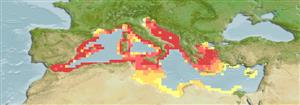Common names from other countries
Classification / Names / Names
Namen | Synonyme | Catalog of Fishes (gen., sp.) | ITIS | CoL | WoRMS
Environment: milieu / climate zone / depth range / distribution range
Ökologie
; tiefenbereich 5 - 800 m (Ref. 93433), usually 100 - 299 m (Ref. 93433). Subtropical; 56°N - 17°S, 83°W - 36°E
Atlantic and the Mediterranean: Antilles to Gulf of Mexico, north to Ireland to Angola and east to Turkey.
Length at first maturity / Size / Gewicht / Alter
Maturity: Lm ? range ? - ? cm Max length : 35.0 cm TL Männchen/unbestimmt; (Ref. 363)
Maximum size: 35 cm (Ref. 363); 30 cm (Ref. 358). Maximum width: 7 cm (Ref. 363). Body: depressed enough with a side fold 5 cm pink power station (Ref. 363); definitely flattened form; is provided with the ventral face with 3 lines with podia. Dorsal tegument: Roughcast wart outgrowths and appendices; the papillae, of big size and white color; being limited to the periphery. Variable coloring, of brown with nuance of yellow to red, the sides being constellated with maculae possible blanches.
Maximum size: 35 cm (Ref. 363); 30 cm (Ref. 358). Methods: Captured by dredgers and trawls, this species is used in some countries of the zone (France, Spain where it is very appreciated in Catalonia). One needs additional information on the mode of Net use carrying of large papillae and separating the faces dorsal and ventral (Ref. 363). Abundant in the continental shelf (Refs. 93433, 122969); also found in the continental slope (Ref. 93433). Lives on rubble (Ref. 111335). Recorded from the upper sublittoral zone of Sidi Medjdoub, Mostaganem, Algeria. Abundant in depths of 150 to 200m with a constant water temperature of 13°C (Ref. 128655).
Life cycle and mating behavior
Geschlechtsreife | Fortpflanzung | Ablaichen | Eier | Fecundity | Larven
Members of the class Holothuroidea are gonochoric and have only one gonad. Spawning and fertilization are both external and some exhibit brooding. Life cycle: Embryos develop into planktotrophic larvae (auricularia) then into doliolaria (barrel-shaped stage) which later metamorphose into juvenile sea cucumbers.
Ramón, M., J. Lleonart and E. Massutí. 2010. (Ref. 93433)
IUCN Rote Liste Status (Ref. 130435)
CITES Status (Ref. 108899)
Not Evaluated
Not Evaluated
Nutzung durch Menschen
Fischereien: kommerziell
| FishSource |
Tools
Internet Quellen
Estimates based on models
Preferred temperature
(Ref.
115969): 13.1 - 15.5, mean 14.2 (based on 91 cells).
Verwundbarkeit
Low vulnerability (25 of 100).
Preiskategorie
Unknown.
